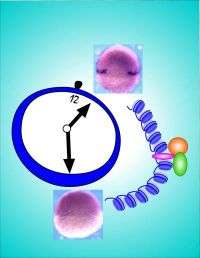Researchers find trigger gene for muscle development

University of Oregon scientists say they have identified a gene that is the key switch that allows embryonic cells to form into muscles in zebrafish.
Much like students in a kindergarten class lining up to go to lunch, the trigger gene, which is identified as Smarcd3, must align correctly with two other genes for muscle formation to begin, a process known as myogenesis, said principal investigator Monte Westerfield, a professor of biology and researcher in the UO Institute of Neuroscience.
The basic research, funded by the National Institutes of Health, was done using zebrafish embryos, which provide a model system for analyzing the genetic control of induction and specification of muscle cells in vertebrates, as well as for many other important health issues. The findings were published online ahead of the regular publication by the Journal of Biological Chemistry.
"Our muscles develop from a particular set of cells in the embryo," Westerfield said. "These muscle precursor cells need to be in the right place at the right time to develop into muscles. Previously it was unknown how the timing of this critical developmental switch is controlled. We discovered the missing factor, Smarcd3, which forms a protein complex that alters the shape of DNA in particular regions of the genome, thus turning on genes required for cells to develop into muscle."
Smarcd3 proteins are part of a chromatin-remodeling complex made up of DNA and proteins that make up chromosomes. It is a transcriptional protein, which means it is important for initiating, in this case, development.
The UO researchers found that muscle formation begins in an embryo's mesoderm when Smarcd3 interacts correctly with two other transcription-factors known as Fgf and Ntl. This specific time-sensitive alignment, the researchers noted, works to trigger the earliest gene expression involved in myogenesis.
Previous research had suggested the requirement of several additional transcription proteins, but the UO team was able to sort through many of the combinations and narrow the field to these three factors. The findings could eventually allow researchers to understand how various combinations of proteins in the chromatin act to regulate the development of different cell types, tissues and organs.
Source: University of Oregon



















